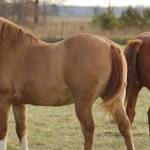Cryotherapy Remains Relevant Treatment for Laminitis

Cryotherapy remains the gold-standard for treatment of early-stage laminitis, according to James Orsini, DVM, director of the Laminitis Institute at New Bolton Center, University of Pennsylvania. Orsini gave a presentation titled “Is Laminitis Preventable? New Technologies to Manage the At-Risk Horse” at the Kentucky Horse Park on June 24, 2010.
In order for cryotherapy to be effective, it must commence during the developmental stage. This is the time immediately after the horse has been placed at risk of developing laminitis but before signs such as lameness, bounding digital pulse, or hoof heat become apparent. The efficiency of cryotherapy can be attributed primarily to the analgesic effects of long-term exposure to cold and to hypometabolism of the hooves. As the hooves chill, the need for glucose by their internal structures wanes, decreasing the metabolic rate of the tissues encased in the hoof capsule and preserving tissues that might otherwise become compromised from a decline in distal blood flow.
The old-standby procedure of standing affected horses in ice baths for long periods of time is a laborious chore. Orsini detailed a new cryotherapeutic technique that uses dry-cold compression therapy to accelerate healing. Rapid, continuous circulation of temperature-regulated water around the hooves provides the appropriate therapy.
For more information on laminitis, read “Recent Research into Laminitis” from the 2008 KER Nutrition Conference.








